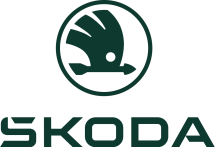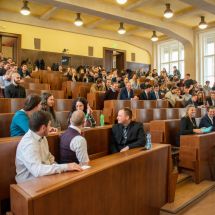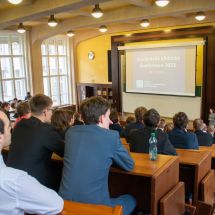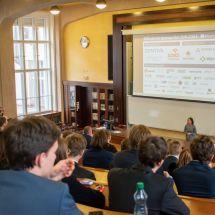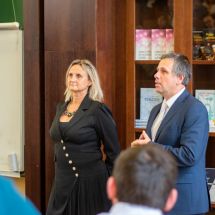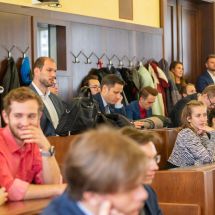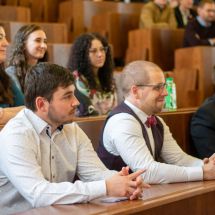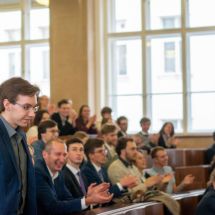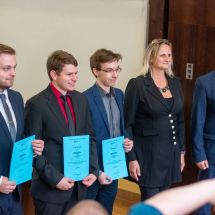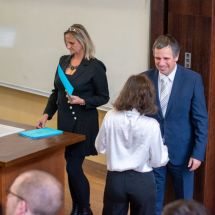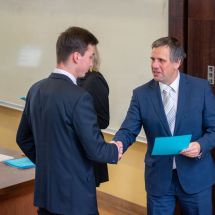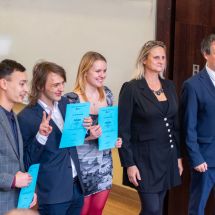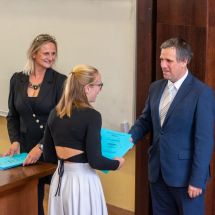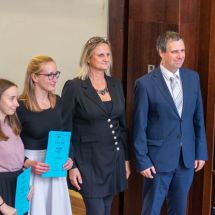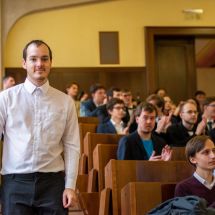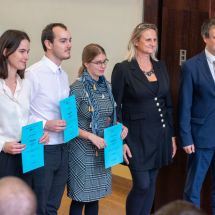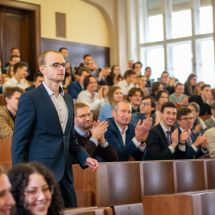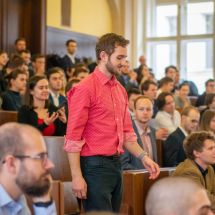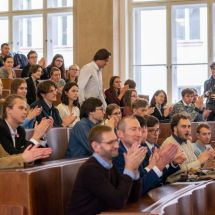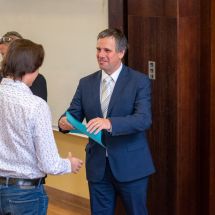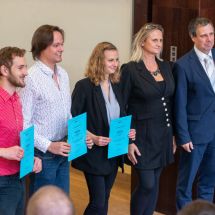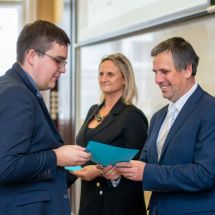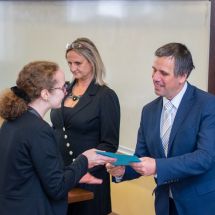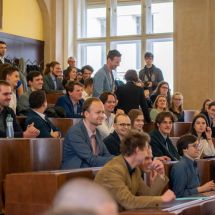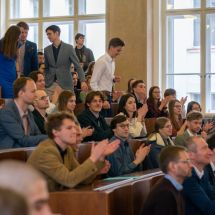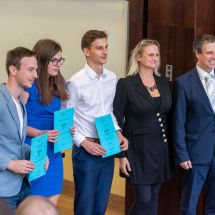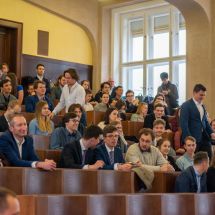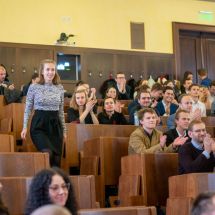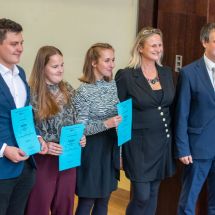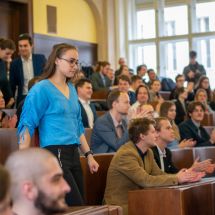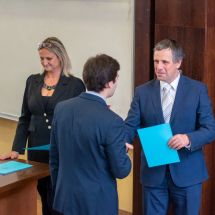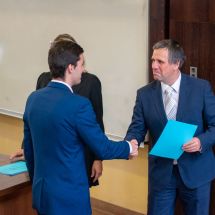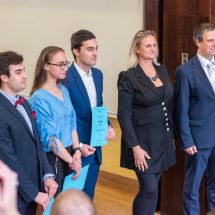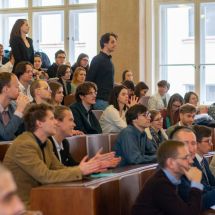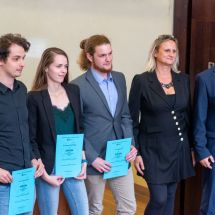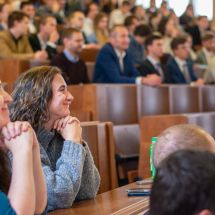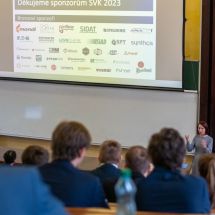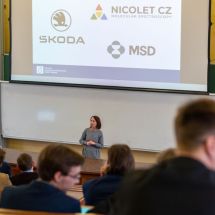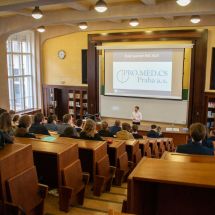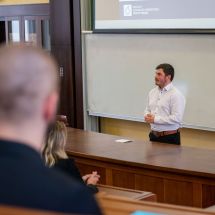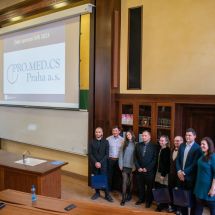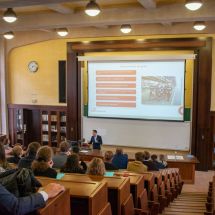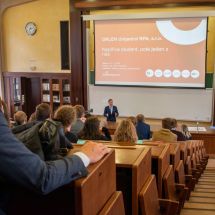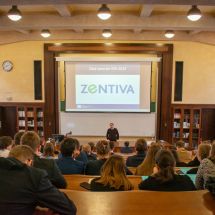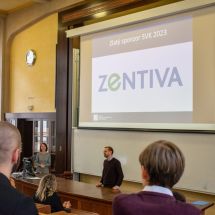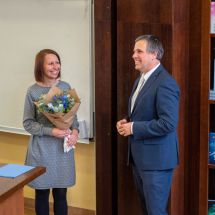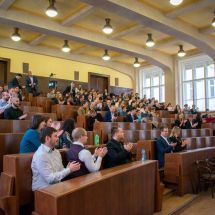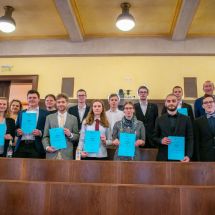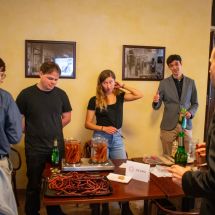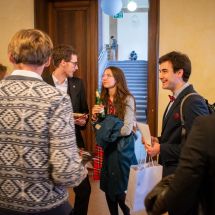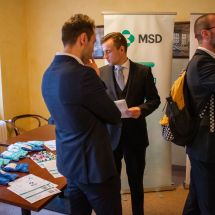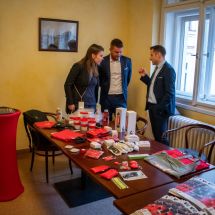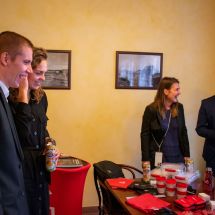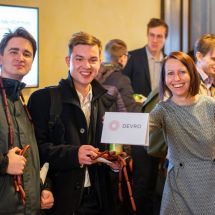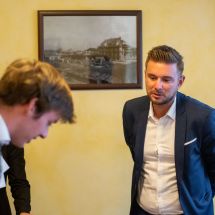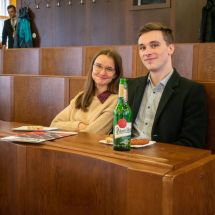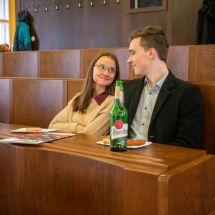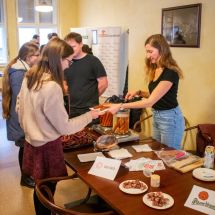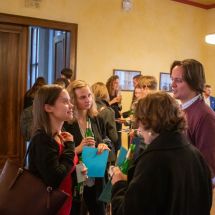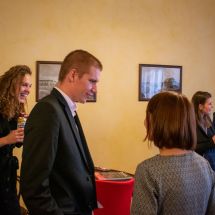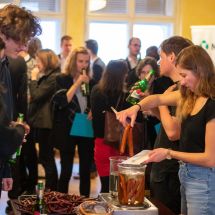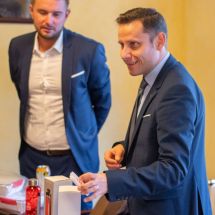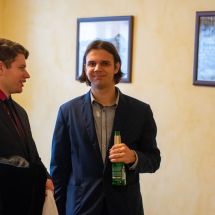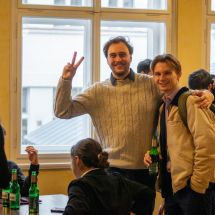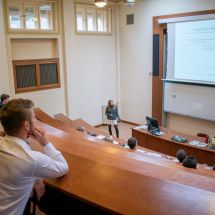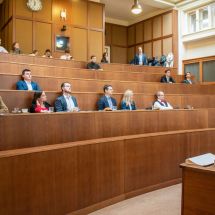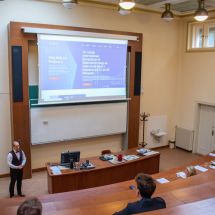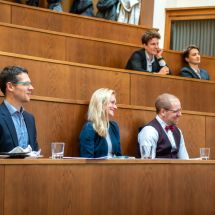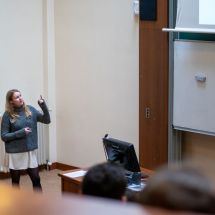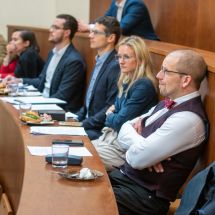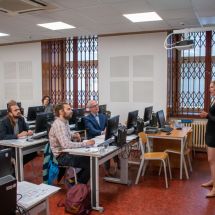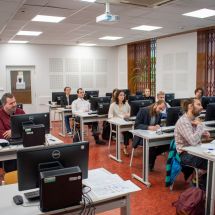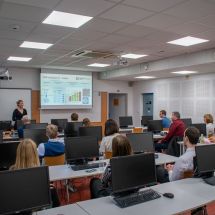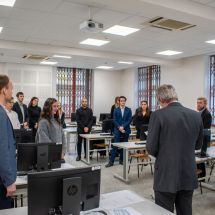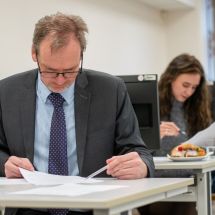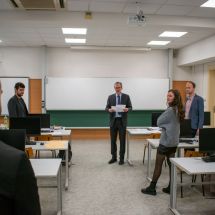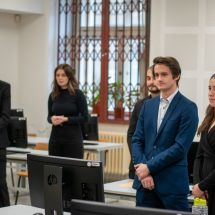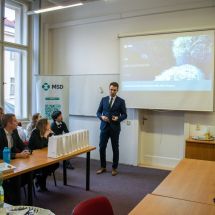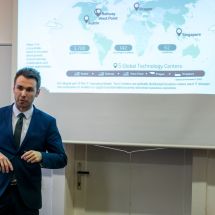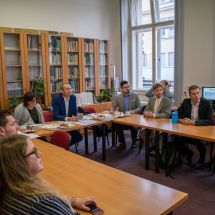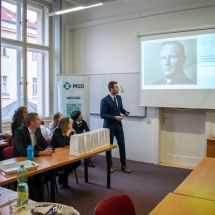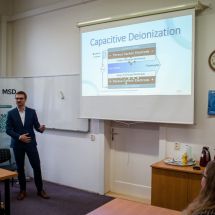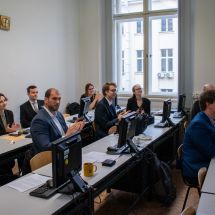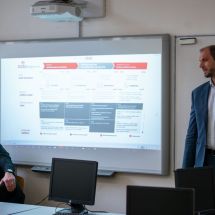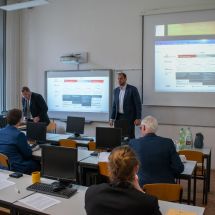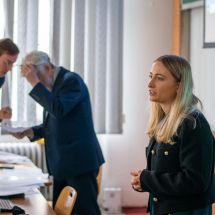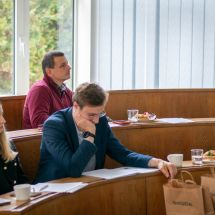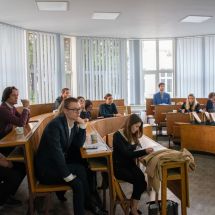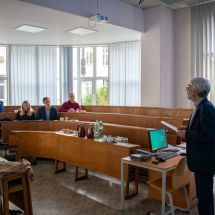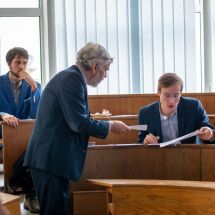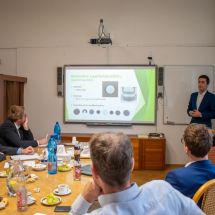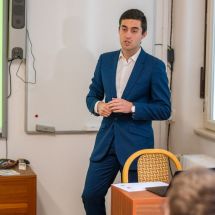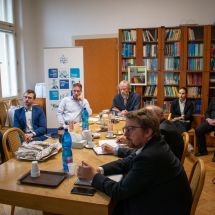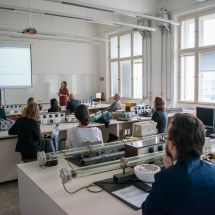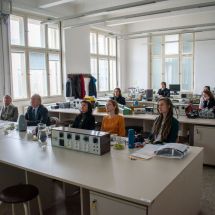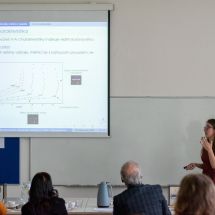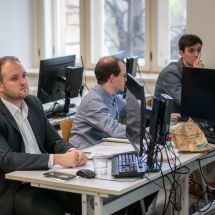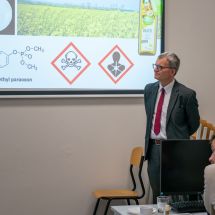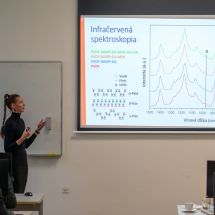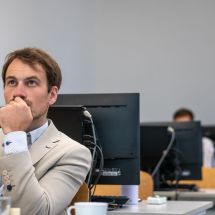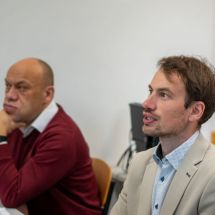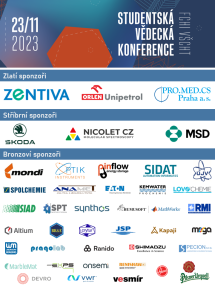|
9:00
|
Bc.
Johana
Fialová
|
M2
|
Mgr. Juraj Fedor, Ph.D.
|
Dissociative electron attachment to CF3I probed by velocity map imaging
|
detail
Dissociative electron attachment to CF3I probed by velocity map imaging
Dissociative electron attachment (DEA) is an effective method of reducing reactive halogen derivates by collisions with electrons, upon which the inert halogen ions are formed. Velocity map imaging (VMI) is a technique that reveals the dynamics of this process. The electron beam is crossed with a molecular beam of the studied molecule, leading to negative ions’ creation. The VMI spectrometer measures their time of flight (TOF) and kinetic energies by utilizing a time-and-position sensitive delay line detector.
My study is focused on the molecule CF3I, trifluoroiodomethane, as it could be a potential substitute for environmentally detrimental CF4, tetrafluoromethane, which is used in plasma processing (semiconductor industry). The advantage of CF3I is its short lifetime in the atmosphere (a few days), in comparison, the atmospheric lifetime of CF4 is 50 000 years (the short lifetime of CF3I is caused by photolytic cleavage of the CF3-I bond). This creates a need to understand the electron-induced chemistry of this compound and its dynamics. For this purpose, we utilize the VMI spectrometer. In my lecture, the results of the analysis of measured data by Pamir Nag PhD. will be presented.
|
|
9:20
|
Bc.
Veronika
Kostková
|
M2
|
doc. Ing. Ctirad Červinka, Ph.D.
|
Capturing the negative thermal expansion of metal–organic frameworks in silico
|
detail
Capturing the negative thermal expansion of metal–organic frameworks in silico
During the past few decades, there has been an increasing interest in metal–organic frameworks (MOFs), because they represent promising materials for a variety of applications, especially gas storage, separation, or catalysis. They draw scientists’ attention due to their large diversity of structures and functions and because of their unique properties – high permanent porosity and extensive surface area.
Another unusual property occurring frequently among MOFs is their negative thermal expansion.
In this work, I investigate whether commonly used computational methods can describe this phenomenon correctly. The first approach being explored is a quasi-harmonic calculation applied to DFT-computed vibrational frequencies and electronic energies. The second method consists of classical force field molecular dynamics simulations. In this case, the force field is optimized to appropriately describe the negative thermal expansion for subsequent use in multicomponent simulations.
|
|
9:40
|
Bc.
Anna
Lamancová
|
M1
|
prof. RNDr. Bc. Petr Slavíček, Ph.D.
|
Photochemistry of acylhydrazones: theory and experiment
|
detail
Photochemistry of acylhydrazones: theory and experiment
Acylhydrazones prove to be particularly fascinating as photoswitches, showcasing dynamic E/Z isomerization behavior under varying conditions. In this work, we focus mainly on two molecules, AH1 and AH2. AH1 exhibits a reversible E/Z isomerization, transitioning between these forms efficiently, while AH2, intriguingly, undergoes E to Z isomerization but lacks the ability to revert back to its original state. Experimental data were gathered through UV-Vis spectroscopy and EPR (Dr. Kovaricek, UCT Prague), shedding light on the distinct behaviors of these molecules under varying conditions. UV-Vis allowed us to track the electronic transitions during isomerization. EPR, on the other hand, offered a closer look at the spin states, providing valuable information about the electronic configurations. In theoretical approach, we employed TDDFT to simulate the spectroscopic data and optimize the structures to the T1 and S1 states. The spin-orbit coupling further enriched our understanding of the electronic transitions during isomerization processes. Our objective is to unravel the difference between these two molecules, elucidating the intricacies of their isomerization processes through a theoretical approach, thereby contributing valuable insights to the field of molecular photoswitches.
|
|
10:00
|
Bc.
Martin
Mašek
|
M1
|
doc. RNDr. Michal Kolář, Ph.D.
|
Molecular dynamics simulations of ancestral ribosome models with protein fragments
|
detail
Molecular dynamics simulations of ancestral ribosome models with protein fragments
Ribosome is a molecular machine orchestrating the protein biosynthesis. At the core of the ribosomal structure, comprised of ribosomal RNA (rRNA) chains and ribosomal proteins, resides the active site called peptidyl transferase center (PTC). There is a quasi-symmetrical region enveloping the PTC, which interestingly is conserved among different species. This intriguing symmetry hints at an ancient evolutionary origin, suggesting that the first protoribosomes consisted only of the inner core of contemporary ribosome and then iteratively accreted. We conducted several all-atom molecular simulations of two protoribosome models using contemporary ribosomes as a template. Our focus was on PTC constructs incorporating various ribosomal protein fragments, aiming to elucidate their role in the structure. These in silico experiments revealed that the presence of protein fragments enhances the rigidity of the rRNA chains, suggesting a potential role in the evolution of ribosome. Looking ahead, we are going to perform coarse grained simulations of the models to extend the simulation time scale which potentially can provide further details about our constructs.
|
|
10:20
|
Bc.
Lukáš
Peterka
|
M1
|
prof. RNDr. Bc. Petr Slavíček, Ph.D.
|
Revealing the Mechanism of Pyrrole and Dipyrrinone Derivatives Oxidation
|
detail
Revealing the Mechanism of Pyrrole and Dipyrrinone Derivatives Oxidation
In this work, I focus on pyrrole and dipyrrinone derivatives as model compounds for studying bilirubin oxidation, particularly significant due to the formation of oxidation products in neonatal jaundice phototherapy and the recognized role of bilirubin as an antioxidant. The experiment in a cooperating laboratory (P. Klán, MU Brno) proposes a novel photooxidation pathway for dipyrrinones, involving electron transfer from the excited dipyrrinone to triplet oxygen, followed by superoxide radical anion addition to the dipyrrinone. This study investigates the suggested mechanism using computational chemistry techniques, primarily employing DFT and the so-called constrained DFT methods. Additionally, semiempirical approaches are used. The results obtained so far are consistent with the experiment and offer insight into the mechanics of the photooxidation.
|
|
10:40
|
Bc.
Veronika
Šritterová
|
M1
|
doc. Ing. Ctirad Červinka, Ph.D.
|
Molecular Modelling of the Internal Dynamics of Porous Metal-Organic Liquids
|
detail
Molecular Modelling of the Internal Dynamics of Porous Metal-Organic Liquids
Porous liquids (PLs) represent an innovative class of materials as they combine the permanent porosity of solid sorbents and the fluid nature of liquids. Adding structured voids into liquids is highly attractive in terms of promising applications including gas capture, catalysis, and separations. This work presents a set of molecular dynamics simulations addressing the structural and dynamic properties of PLs comprised of the selected ionic liquids (ILs) and metal-organic frameworks (MOFs), in particular ZIF-8. In this study, dynamic characteristics of the fluid in close proximity to the free surface of the crystal structure are investigated at the atomic resolution. Simulated structural and dynamic properties of the solvating layer of IL are compared with those acquired from simulations of pure substances. It is ascertained that the confinement of the ILs within the MOF pore influences the structural organization. The ultimate objective is in the analysis of the phase behavior, which is affected by both the varying molecular size of the IL and the pore dimensions of MOF. Based on the obtained findings, all considered ILs are supposed to retain their fluid properties in sufficiently sized pores, making them suitable for the formation of porous liquids based on ZIF-8.
|


